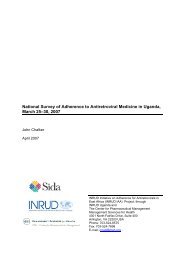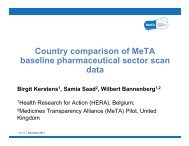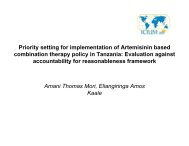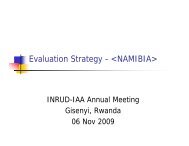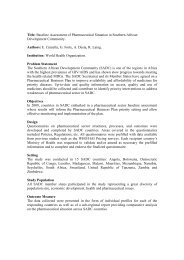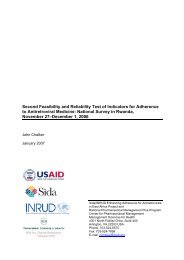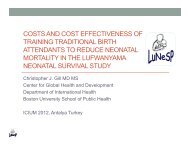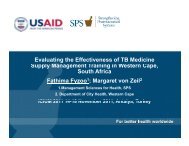How to investigate levels of Adherence to antiretroviral ... - INRUD
How to investigate levels of Adherence to antiretroviral ... - INRUD
How to investigate levels of Adherence to antiretroviral ... - INRUD
Create successful ePaper yourself
Turn your PDF publications into a flip-book with our unique Google optimized e-Paper software.
<strong>How</strong> <strong>to</strong> Investigate <strong>Adherence</strong> <strong>to</strong> Antiretroviral Treatment:<br />
An Indica<strong>to</strong>r-Based Approach<br />
12. Presence <strong>of</strong> labora<strong>to</strong>ry— Does the facility have access <strong>to</strong> a functioning labora<strong>to</strong>ry<br />
system for measuring CD4 counts or viral loads so that results can be ready for the<br />
patient's next routine visit?<br />
Rationale<br />
Source <strong>of</strong> data<br />
Data collection<br />
Computation<br />
Comments<br />
A functioning labora<strong>to</strong>ry that can measure CD4 counts or viral loads in or near<br />
the facility or within the programme makes it more likely that these clinical<br />
markers will be moni<strong>to</strong>red on a regular basis, which can promote discussion<br />
about adherence.<br />
Facility interview and observation.<br />
At the time <strong>of</strong> data collection, ask whether the facility has a functioning<br />
labora<strong>to</strong>ry on-site, within the programme or within a five-minute walk that can<br />
produce CD4 or viral load results in time for the patient's next routine visit and<br />
whether the test or transport would cost the patient anything.<br />
If the labora<strong>to</strong>ry is functioning and provides the test and transportation for free,<br />
then record Yes. Otherwise, record No.<br />
Labora<strong>to</strong>ry needs <strong>to</strong> be functioning on the day <strong>of</strong> data collection<br />
Some facilities have access <strong>to</strong> a labora<strong>to</strong>ry in a central facility within their programme and<br />
may either take blood <strong>to</strong> send <strong>to</strong> the facility or send the patient <strong>to</strong> the central facility for<br />
testing. From the patient’s point <strong>of</strong> view, the first option is much easier and less time<br />
consuming. If patients have <strong>to</strong> pay for their own transport, many may not be able <strong>to</strong> afford<br />
it. This then would not be defined as access.<br />
13. CD4 and viral load testing rate.<br />
Rationale<br />
Source <strong>of</strong> data<br />
Data collection<br />
Computation<br />
Comments<br />
Increase in CD4 count over time is an indirect measure <strong>of</strong> success in controlling<br />
HIV; routine testing for CD4 can assist in adherence moni<strong>to</strong>ring.<br />
Facility interview.<br />
While doing the facility interview, ask about the intended frequency for CD4 and<br />
viral load tests and whether the intended frequency is met.<br />
CD4 testing rate—The stated number <strong>of</strong> months between routine CD4 tests for<br />
each patient.<br />
Viral load testing rate—The stated number <strong>of</strong> months between routine viral load<br />
tests for each patient.<br />
Not all facilities do routine CD4 counts or viral loads for all patients. Many<br />
facilities may claim <strong>to</strong> do them routinely but in fact do not. This method does<br />
not allow for checking this.<br />
20



